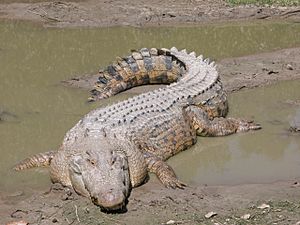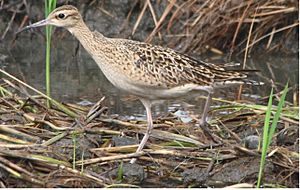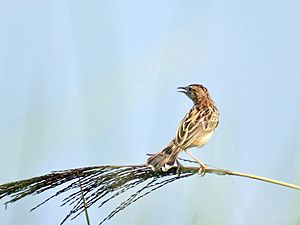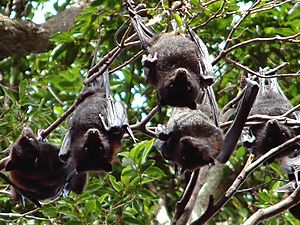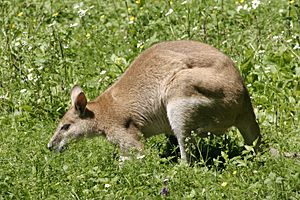Ord River Floodplain facts for kids
The Ord River floodplain is a huge, flat area of land near the lower Ord River in northern Western Australia. It's a very special place with rivers, creeks that sometimes dry up, and muddy areas near the ocean. You can find lots of mangrove trees here, and it's home to big saltwater crocodiles and many different waterbirds.
This area is so important that on June 7, 1990, 1,384 square kilometers of it were named a Ramsar Site. This means it's recognized internationally as a vital wetland area.
Quick facts for kids
Designations
|
|
| Official name: Ord River Floodplain | |
| Designated: | 7 June 1990 |
|---|---|
| Reference #: | 477 |
Contents
What is the Ord River Floodplain?
This special area is about 8 kilometers east of the town of Wyndham. It includes the Ord River and Parry Lagoons nature reserves, plus some extra land.
The Ord River has two big dams upstream: Lakes Argyle and Kununurra. These dams have changed how the river flows. Now, water flows constantly, even during the dry season. This has turned the lower Ord River from a "dry tropics" river into a "wet tropics" river.
The southern part of the site has Parry Creek. This includes 20 kilometers of creek that flows only during the wet season. This area floods when it rains a lot. It dries out quickly in the dry season, except for some waterholes and muddy areas. The southern part is freshwater, while the northern part is often flooded with saltwater or has salty soil.
The lower Ord River goes from the Parry Creek floodplain north to the Cambridge Gulf. The upper parts of the river always have fresh water. But the lower parts, when not flooding, become salty because of the tides. Near the coast, the tides can go up and down by up to 8 meters!
At the mouth of the Ord River, the site spreads north along the coast. It includes the "False mouths of the Ord." This is a maze of small channels, muddy areas that are covered and uncovered by tides, and low muddy islands. This area gets only a little fresh water from small creeks that dry up easily.
Climate of the Floodplain
The Ord River floodplain has a dry tropical climate. Most of the rain falls during the monsoon season, which is hot and humid, from November to March. Wyndham gets about 695 millimeters of rain each year.
The dry season is mild, with steady winds from the southeast. The average highest temperature changes from 30 °C in July to 39 °C in December.
Plants and Animals of the Ord River Floodplain
Different Types of Plants
Scientists have found ten main types of plant areas here. These include muddy flats, mangroves, sand dunes, grasslands, and different kinds of woodlands. There are also rainforests and areas around springs.
About 335 native plant species have been found here. There are also 16 introduced species.
The eastern coast of the Cambridge Gulf is one of the best places for mangroves in the Kimberley region. It has many different kinds of mangroves, with 14 species found here. The mangroves grow in different zones. Closer to the sea, they form a woodland about 8 meters tall. Further inland, they can be 10 to 15 meters tall.
Amazing Birds
The seasonal wetlands on the floodplain are home to huge numbers of waterbirds. Many hardhead ducks, grey teal ducks, and plumed whistling ducks live here.
The lagoons are also a very important spot for shorebirds. Thousands of little curlews and Oriental pratincoles have been counted. Hundreds of wood sandpipers have also been seen. The Parry Lagoons are probably the most important place in Australia for both wood and marsh sandpipers.
When there's a lot of rain, the lagoons become major breeding areas for waterbirds. Up to 77 different bird species have been recorded around Parry Creek. The grasslands are the only place in Western Australia where zitting cisticolas live naturally. The mangroves have 12 of the 13 types of land birds that only live in mangroves or rainforests in Western Australia, including the black butcherbird. In total, about 200 bird species have been seen at this site!
Other Cool Animals
The lower Ord River has a very high number of saltwater crocodiles. The mangroves are home to at least six types of small bats, the black flying-fox, and the grassland melomys.
Other mammals found here include the northern nail-tail wallaby, agile wallaby, long-haired rat, and Kimberley rock rat. The largetooth sawfish, which is a fish that is in great danger of disappearing, has also been found in the lower Ord River.
People and the Floodplain
Aboriginal people have a deep and spiritual connection to the land and waters of the Ord River. This area is part of the traditional lands of the Miriuwung and Gajerrong language groups. There are many important cultural sites here, including places for ceremonies, stories, and burials.
The Ord River floodplain is also a popular place for tourists to visit. Some people look for diamonds in the river's gravel. The land around the floodplain is used for cattle grazing.


